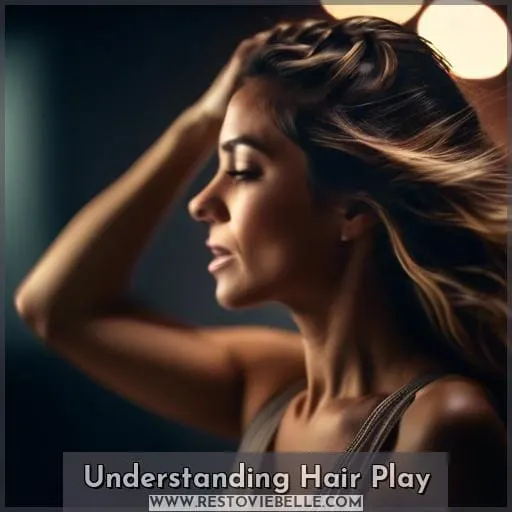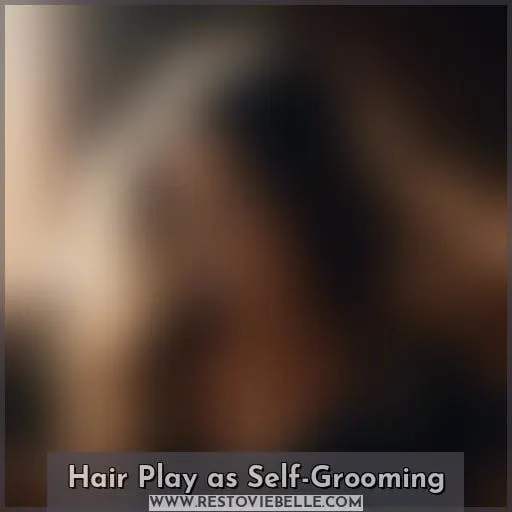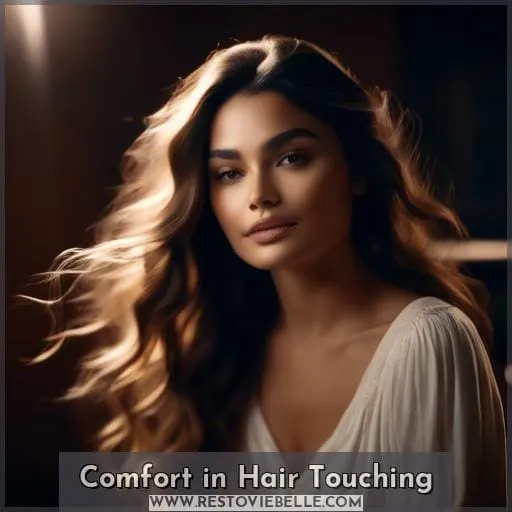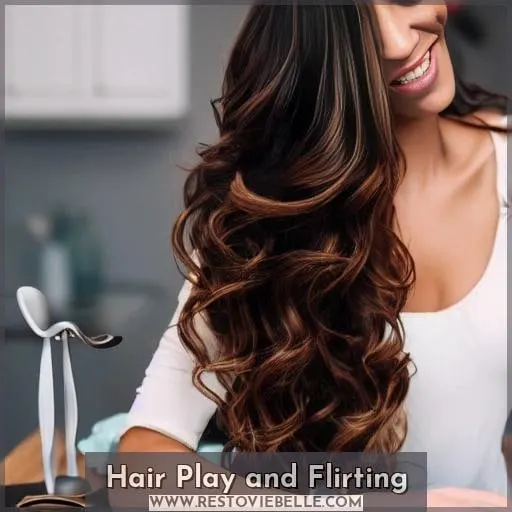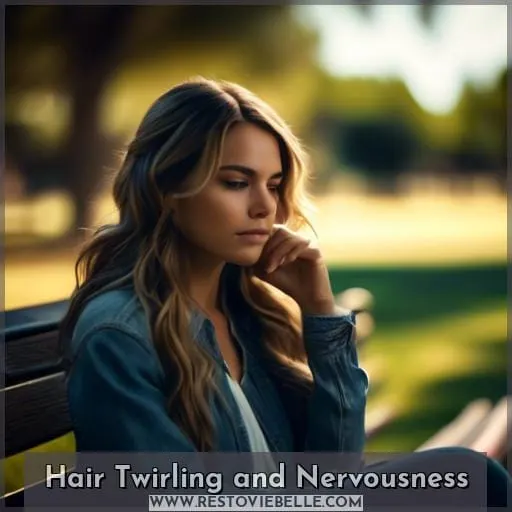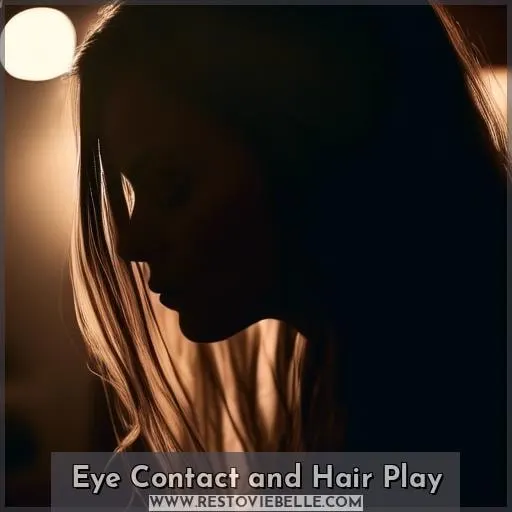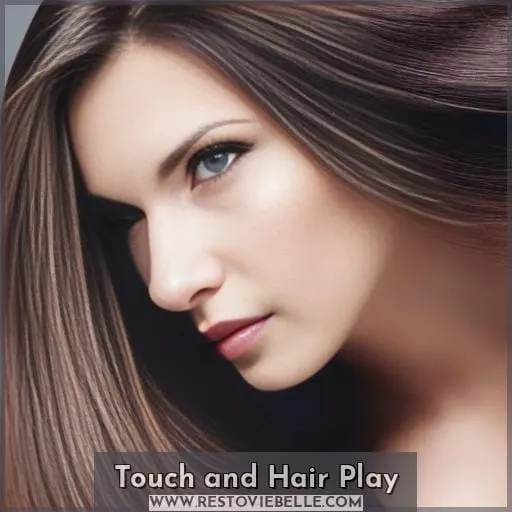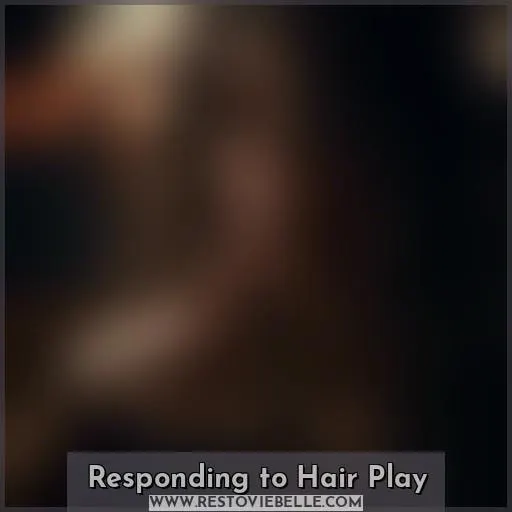This site is supported by our readers. We may earn a commission, at no cost to you, if you purchase through links.
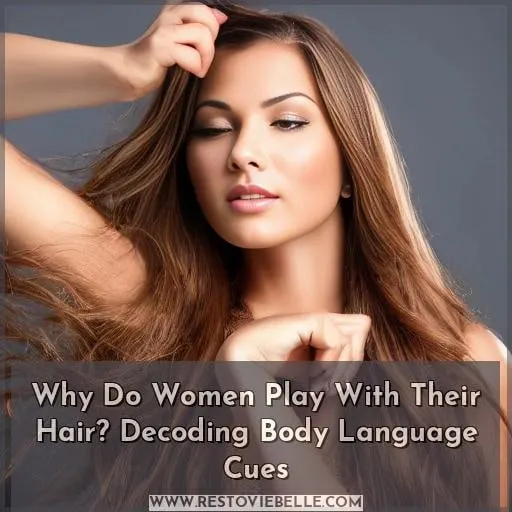 You might think hair play is just a quirky habit, but it’s actually a window into a woman’s thoughts and feelings.
You might think hair play is just a quirky habit, but it’s actually a window into a woman’s thoughts and feelings.
When you catch someone twirling their locks, they’re not just fiddling aimlessly; they’re communicating.
From soothing nerves to signaling interest, the reasons why women play with their hair are as varied as they are fascinating.
Dive into the nuances of this body language cue and unlock the secrets behind each strand.
Women play with their hair for various reasons, including as a self-soothing gesture or to convey interest and attraction.
Table Of Contents
- Key Takeaways
- Understanding Hair Play
- Hair Play as Self-Grooming
- Comfort in Hair Touching
- Hair Play and Flirting
- Hair Twirling and Nervousness
- Habitual Hair Play
- Eye Contact and Hair Play
- Touch and Hair Play
- Interpreting Hair Play Context
- Responding to Hair Play
- Frequently Asked Questions (FAQs)
- How does cultural background influence the interpretation of hair play in social interactions?
- Can hair play be an indicator of psychological conditions beyond nervousness or anxiety, such as OCD or trichotillomania?
- How does the frequency and manner of hair play change with age, and does it signify different things at different life stages?
- In what ways can hair play impact professional interactions or perceptions in the workplace?
- Are there any historical or evolutionary explanations for why hair play is a common behavior across different genders and cultures?
- Conclusion
Key Takeaways
- Flirtatious Gestures: Women often play with their hair as a non-verbal form of communication, signaling interest and attraction towards someone. This behavior can include twirling hair around the finger, running fingers through hair, and other playful actions that draw attention to themselves.
- Nervous Energy Release: Hair play can serve as a physical response to anxiety or stress, acting as a self-soothing mechanism. It helps in releasing pent-up tension and provides temporary comfort, especially in situations that induce nervousness.
- Habitual Behavior: For some women, playing with their hair is a deeply ingrained habit rather than a conscious action. It can be a comforting action performed subconsciously, often without any particular intention or awareness.
- Grooming and Confidence Boosting: Adjusting and playing with hair can also be a way for women to ensure they look their best, serving as a confidence booster. This behavior allows them to feel more in control of their appearance and exude self-assurance.
Understanding Hair Play
When you notice a woman playing with her hair, it’s often more than just a casual gesture.
This action can be a form of nonverbal communication, signaling anything from nervous energy to a flirtatious vibe.
It might also be a habitual behavior, something she does unconsciously without any particular intent.
Nonverbal Communication
When you play with your hair, you’re engaging in a form of nonverbal communication that can reveal much about your emotional state and intentions.
- Hair touching can be a flirtatious gesture, signaling attraction or interest.
- It may reflect gender differences or cultural influences, as norms around hair and grooming vary widely.
- Age-related variations in behavior might also influence how and why someone plays with their hair.
- The act of hair playing can indicate different emotional states, from nervousness to confidence.
Nervous Energy
When you find yourself twirling your hair, it might be more than just a mindless habit. This action can be a physical response to nervous energy, serving as an anxiety release.
Hair touching and hair play can also act as a confidence booster, subtly signaling your comfort or unease in a situation. While it’s a common behavior, it’s important to be mindful of it, especially if it becomes excessive, as it could lead to hair damage.
If you’re twirling your hair often, it might be worth exploring whether it’s a sign of underlying nervousness or simply a comforting habit.
Habitual Behavior
Continuing from the discussion on nervous energy, let’s delve into habitual behavior.
You might find yourself wrapping or twirling your hair without even thinking about it. This habitual behavior can be a comforting action, helping you to relieve boredom or anxiety. It’s not always about grooming or appearance; sometimes, it’s just a reflex, something you do when your mind is elsewhere.
Whether it’s hair flipping during a conversation or hair braiding while daydreaming, these actions can be gender-neutral and don’t necessarily signal interest. However, if accompanied by sustained eye contact or other signs of flirting, it could be more than just a habit.
Hair Play as Self-Grooming
Hair play can be a multifaceted behavior, often serving as a form of nonverbal communication that can reflect various emotional states or intentions. When you engage in hair play as self-grooming, it’s not just about keeping your locks in place.
This act can be a comforting gesture that helps you soothe yourself in moments of stress or boredom. It’s also a way to boost your confidence, as grooming can make you feel more put together and attractive.
In the context of attraction, hair play might be used to draw attention to your features, signaling youth and fertility, which can be particularly appealing in a dating scenario. The comfort found in touching your hair can also be a subconscious effort to calm nerves or to simply enjoy the sensation, which can be quite pleasurable and reassuring.
Comfort in Hair Touching
When you find yourself playing with your hair, it’s often more than just a casual gesture. It can be a source of comfort, a way to deal with moments of insecurity, or simply a means to alleviate boredom.
Women, in particular, might engage in this behavior for various reasons, and understanding why can be quite enlightening.
- Imagine the soft texture of your hair as you twirl a strand around your finger, a soothing sensation that calms your nerves.
- Envision the habitual motion of running your hands through your hair while lost in thought, a familiar action that brings a sense of normalcy.
- Picture the occasional hair flip over the shoulder, a gesture that might reflect a momentary feeling of restlessness or boredom.
- Consider the gentle tug at a lock of hair while daydreaming, an unconscious movement that can offer a brief escape from reality.
Whether it’s a comforting habit formed over time or a subconscious effort to boost confidence, hair play is a nuanced form of nonverbal communication. It’s not just about vanity; it’s a multifaceted expression that can reveal a lot about a person’s emotional state.
So, why do women play with their hair? It’s a gesture that intertwines comfort, habit, insecurity, and sometimes, just a way to pass the time.
Hair Play and Flirting
When you notice a woman playing with her hair while engaging with you, it’s a moment ripe with potential meanings.
This gesture can be a subtle, yet powerful, indicator of her interest, serving as a non-verbal cue that she might be flirting.
However, it’s crucial to consider the context and other body language signals she’s sending to accurately interpret her intentions.
Attraction Signals
When deciphering the subtle language of attraction, hair play stands out as a fascinating cue. It’s not just a casual gesture; it often carries deeper meanings, signaling everything from flirtatious interest to unconscious invitations for closer interaction.
Understanding these signals can offer insights into the dynamics of attraction and interest.
Here’s a quick guide to interpreting hair play in the context of attraction:
| Attraction Cue | Possible Interpretation |
|---|---|
| Twirling hair around finger | A flirtatious maneuver signaling romantic interest. |
| Showing inside of wrist while playing with hair | Exposes a vulnerable area, suggesting openness and attraction. |
| Running fingers through hair | A confidence boost, glamming up to catch your attention. |
These gestures, part of the broader spectrum of nonverbal communication, often occur subconsciously. They serve as subtle invitations to engage, reflecting a person’s interest and desire for intimacy or connection.
While these cues can be intriguing, it’s crucial to consider them within the broader context of the interaction and alongside other nonverbal signals for a fuller understanding of someone’s feelings or intentions.
Subconscious Invitations
When a woman plays with her hair in your presence, it’s often more than just a casual gesture. This act can be a flirtatious maneuver, a subtle cue signaling subconscious attraction.
It’s an unspoken invitation, a nonverbal signal that she might be interested in you. Whether she’s twirling her locks around her finger or tossing her hair over her shoulder, these actions can be flirtatious gestures that invite further interaction.
It’s important to pay attention to these subtle cues, as they can reveal a desire for a deeper connection or indicate that she’s opening the door for flirtation. Remember, these actions aren’t always conscious decisions but can be instinctive ways of expressing interest and attraction.
Hair Twirling and Nervousness
When you notice a woman twirling her hair, it might be more than just a casual gesture. This action can often be a physical response to feelings of restlessness or anxiety.
If you see someone frequently playing with their hair, it could be a sign that they’re experiencing stress or nervousness, especially if accompanied by other indicators like avoiding eye contact or fidgeting.
Anxiety Release
When you find yourself twirling your hair, it’s not just a casual gesture; it can be a sign of anxiety seeking release. This subconscious action serves as a stress relief, providing a distraction technique from overwhelming thoughts or situations.
- Self-soothing: It’s a way to comfort yourself in moments of insecurity or discomfort.
- Distraction technique: Diverts your mind from stressors, easing tension.
- Coping mechanism: Helps manage feelings of nervousness or restlessness.
Restlessness
When you’re feeling restless, hair fidgeting can be a common outlet. It’s a way to release that pent-up energy, often without even realizing it.
If you’re twirling your hair, it might be more than just a casual habit; it could be a sign of hair anxiety or stress. This action can provide a sense of hair comfort, especially in moments of uncertainty or when you’re feeling overwhelmed.
However, it’s important to be aware that excessive hair twirling can lead to hair insecurity or damage. If you find yourself constantly playing with your hair, it might be worth considering whether it’s a soothing mechanism for nervous energy or if there’s an underlying issue that needs addressing.
Habitual Hair Play
You might find yourself twirling your hair between your fingers without even thinking about it.
It serves as a simple, subconscious method to distract yourself or find a moment of peace.
It can be a part of your personal style or a way to boost your confidence in social situations.
Unconscious Actions
As you’ve noticed from the nervous twirls in your hair, such actions can often be subconscious.
- Habitual Comfort: Just like a cozy blanket, habitual hair twirling can be a source of comfort, helping you soothe yourself in moments of idleness or stress.
- Psychological Expression: Your hair play might reflect deeper psychological states, such as anxiety or boredom, without you even realizing it.
- Social and Cultural Context: Hair twirling isn’t just personal; it’s influenced by gender differences and cultural norms, which shape how this behavior is perceived in various social situations.
Boredom Relief
Playing with hair can serve as a distraction from boredom, offering a simple yet effective way to relieve restlessness and anxiety. This habit often emerges unconsciously, as individuals seek comfort or a way to pass the time during dull moments.
While it’s a seemingly benign action, it’s rooted in the human need for sensory stimulation and emotional regulation. Whether you’re lost in thought, trying to stay awake during a monotonous meeting, or simply unwinding, twirling your hair can be a soothing gesture that helps navigate moments of boredom without demanding much effort or thought.
Eye Contact and Hair Play
When you notice a woman playing with her hair while maintaining eye contact, it’s possible she’s signaling her interest in you. This gesture, combined with a steady gaze, can be a powerful nonverbal cue of attraction.
However, if she avoids eye contact while twirling her hair, it may indicate she’s feeling nervous or shy. It’s important to read these signals in conjunction with other body language cues to understand her intentions accurately.
Interest Indication
Continuing from the habitual reasons behind hair play, let’s delve into how these actions can signal interest. When you catch someone’s eye and they engage in hair play, it’s worth considering the message they might be sending.
- Hair tossing can be a flirtatious act, often meant to draw attention to oneself.
- Hair flipping might indicate a desire to show off one’s physical features, like the neck.
- Hair twirling around a finger can be an unconscious sign of attraction.
- Hair stroking could suggest a comfort with intimacy or a desire for closeness.
- Hair braiding in someone’s presence may be a sign of comfort and a subconscious invitation for interaction.
Nervousness Sign
As you’ve learned about the potential attraction signals in hair play, it’s also important to recognize when it’s a sign of nervousness. Hair twirling can be a subconscious action that serves as an anxiety release. When someone avoids eye contact while playing with their hair, it may indicate nervousness rather than interest.
| Hair Play Behavior | Possible Meaning | Body Language Context |
|---|---|---|
| Twirling hair around finger | Nervous habit or anxiety release | May accompany lack of eye contact |
| Playing with ends of hair | Sign of restlessness or discomfort | Often occurs in stressful situations |
| Pulling at hair | Expression of stress or anxiety | Can be observed alongside fidgeting |
| Avoiding eye contact | Indication of nervousness or shyness | Look for other signs of discomfort |
| Fidgeting | General nervous energy | May include other self-soothing gestures |
Touch and Hair Play
When you notice a woman playing with her hair while engaging with you, it’s a gesture that’s rich with potential meanings.
This act can signal a romantic interest or a desire to establish a closer connection. It’s a subtle yet powerful way of expressing attraction, where the physical act of touching or twirling her hair serves as an unspoken invitation to notice her and possibly reciprocate the interest.
Pay attention to these cues, as they’re part of the intricate dance of nonverbal communication, offering you a chance to respond and deepen the interaction.
Romantic Interest
When you catch someone’s eye and they begin to play with their hair, it’s a moment filled with potential. This subtle attraction could be a sign of romantic interest, a nonverbal communication that’s both intriguing and inviting.
As you’ve just shared a meaningful glance, their fingers twirl a strand of hair—a subconscious invitation to engage further. It’s a dance of flirting signals, where each touch and toss of the hair speaks volumes more than words could.
In these instances, it’s essential to pay attention to the context and other cues to truly understand the message being conveyed. This hair play could be a sign of wanting to get closer, a light touch that whispers of a desire for intimacy.
Desire for Closeness
When someone touches, strokes, twirls, pulls, or smooths their hair while interacting with you, it might signal a desire for closeness. This form of hair play can be a subtle yet powerful way to express interest and create a sense of intimacy.
- Hair touching: Gentle strokes through the hair can indicate comfort and a wish to connect.
- Hair stroking: Smooth, deliberate strokes suggest an attempt to soothe or attract attention.
- Hair twirling: Twirling hair around a finger often signifies flirtation or deep thinking.
- Hair pulling: Lightly pulling strands might be a sign of playful behavior or slight nervousness.
- Hair smoothing: Running hands through or smoothing down hair can denote a desire to look one’s best for the other person.
These actions, especially when combined with other nonverbal cues like eye contact or smiling, can hint at a person’s interest in developing a closer relationship or exploring a romantic connection.
Interpreting Hair Play Context
When you’re trying to understand why a woman plays with her hair, it’s crucial to consider the social setting and any accompanying nonverbal cues.
In a relaxed environment, hair play might be less about stress and more about comfort or habit. To get a clearer picture, observe if her hair play is paired with other signals like steady eye contact, which could indicate attraction, or tight lips, which might suggest discomfort.
Social Setting Considerations
When you notice someone playing with their hair, it’s crucial to consider the social setting. This behavior can be influenced by etiquette, cultural norms, and personal style.
In a relaxed social environment, hair play might be a casual, comforting action. However, in a formal setting, it could be a sign of nervousness or a breach of etiquette.
Cultural influences also play a significant role; what’s considered flirtatious in one culture might be seen as inappropriate in another. Always observe specific behaviors and the context to understand the message behind hair play.
Other Nonverbal Cues
When considering hair play in social interactions, it’s crucial to recognize that it’s not just a personal habit but can also be influenced by cultural differences and social norms.
While hair twirling might be a gender-neutral behavior, individual preferences and emotional regulation play a significant role in why someone might engage in this action. For instance, in some cultures, hair is deeply symbolic and touching it could carry different meanings than in others.
It’s important to be mindful of these nuances and not to make hasty assumptions based solely on one’s own cultural perspective.
Additionally, while hair play can be a sign of nervousness or attraction, it’s essential to consider the broader context and other nonverbal cues to understand the person’s feelings accurately.
Responding to Hair Play
When you notice someone playing with their hair, it’s a nuanced form of communication that can signal anything from attraction to nervousness.
If you’re on the receiving end of these signals, it’s important to read the situation and respond appropriately. Eye contact cues can be telling; if they’re coupled with hair play, it might indicate interest.
However, remember that nervous responses, like fidgeting with hair, are also common.
Engage with confidence signals, like a warm smile or a nod, to show you’re approachable. If the context feels right, initiate a playful conversation to explore the connection further. Flirting tips suggest light-hearted teasing or compliments can be effective, but always be mindful of the other person’s reactions and respect their boundaries.
Frequently Asked Questions (FAQs)
How does cultural background influence the interpretation of hair play in social interactions?
Cultural background deeply influences how hair play is interpreted in social interactions. This shaping perceptions of flirtation, nervousness, or habit. It’s crucial to understand these cultural nuances to avoid misinterpretations and foster meaningful connections.
Can hair play be an indicator of psychological conditions beyond nervousness or anxiety, such as OCD or trichotillomania?
Hair play can indeed signal conditions like OCD or trichotillomania.
Repetitive hair pulling can lead to noticeable hair loss and distress.
How does the frequency and manner of hair play change with age, and does it signify different things at different life stages?
Nearly 90% of your hair is growing at any given time.
As you age, this growth slows.
Hair growth may reflect changing concerns or self-perception at each life stage.
In what ways can hair play impact professional interactions or perceptions in the workplace?
In the workplace, hair play may be perceived as unprofessional or distracting, potentially undermining your credibility and authority.
It’s crucial to manage such habits to maintain a polished image.
Are there any historical or evolutionary explanations for why hair play is a common behavior across different genders and cultures?
Over 20% of Black women have faced workplace hair discrimination, a stark reminder of the deep-seated biases that persist.
Hair play, across genders and cultures, likely stems from evolutionary cues related to social bonding and grooming behaviors.
Conclusion
Imagine you’re at a social gathering, and you notice someone you’re interested in frequently playing with their hair while chatting with you. This gesture, often overlooked, can be a rich source of insight into their thoughts and feelings.
As we’ve explored, women play with their hair for a myriad of reasons, ranging from self-soothing during moments of nervousness to unconsciously signaling attraction. It’s a nuanced form of nonverbal communication that, when observed in conjunction with other cues like eye contact and physical proximity, can reveal much about someone’s comfort level, interest, or even boredom.
So, next time you catch someone twirling their locks, remember it’s not just a simple habit; it’s a window into their inner world. Understanding why women play with their hair can deepen your empathy and enhance your interactions, making you a more attentive and responsive companion.

